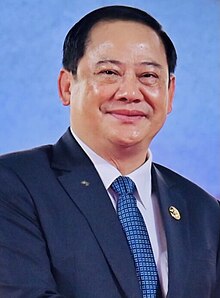| Prime Minister of the Lao People's Democratic Republic | |
|---|---|
| ນາຍົກລັດຖະມົນຕີ ແຫ່ງ ສປປ ລາວ | |
 | |
 | |
since 30 December 2022 | |
| Style | Your Excellency |
| Type | Head of government |
| Member of | |
| Residence | Building of the Office of the Prime Minister |
| Seat | Vientiane |
| Nominator | President |
| Appointer | National Assembly |
| Term length | Maximum of two five-year terms |
| Constituting instrument | Constitution of Laos Law on Government |
| Inaugural holder | Phetsarath Ratanavongsa |
| Formation | 21 August 1941 |
| Deputy | Deputy Prime Minister |
 |
|---|
|
|
The Prime Minister of the Lao People's Democratic Republic, formerly the chairman of the Council of Government of the Lao People's Democratic Republic, is the head of government of Laos. The highest position in the government, they direct the country's executive branch. The prime minister is accountable to the president, the National Assembly and the country's only legal party: the Lao People's Revolutionary Party (LPRP). The current prime minister is Sonexay Siphandone, who was elected in 2022.
The Kingdom of Luang Phrabang was the first Laotian state to establish the office of prime minister. The Constitution of the Kingdom of Laos, ratified in 1947, established the post of Prime Minister of the Kingdom of Laos. The kingdom was abolished on 2 December 1975, when the National Congress of People's Representatives established the Lao People's Democratic Republic. The congress established the office of prime minister, forming the First Government on that day. The Supreme People's Assembly (SPA) approved the Law on the Council of Government, regulating the government's decision-making process, in 1982. The Constitution was approved on 14 August 1991, and the Prime Minister was made subordinate to the President.
Although the Constitution and the Law on Government do not stipulate any qualifications needed to be elected prime minister except for a minimum age of twenty, the law implies that the prime minister must be a member of the LPRP. Every prime minister since the communist seizure of power on 2 December 1975 has been a member of the LPRP Central Committee and the party's Politburo. Of the seven prime ministers since 1975, two served concurrently as LPRP General Secretary; since 1998, however, the general secretary normally serves concurrently as the president.
The prime minister is nominated by the president and elected for a five-year term by the National Assembly. The nominee must receive a majority vote to be elected, and the officeholder can serve a maximum of two terms. The prime minister is responsible for controlling the government's apparatus and composition. They have the right to propose the appointment, reassignment, and removal of minister-level officials and provincial governors to the National Assembly, and is empowered to control and monitor central, provincial and municipal state bodies.
